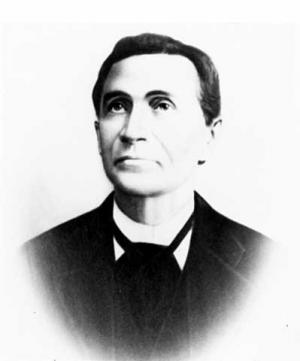Tiwakan (Sacred Lodge), also known as Gabriel Renville, was born in 1825 to "mixed-blood" (individuals of both European and Dakota ancestry) parents but was raised by his stepfather Joseph Akipa Renville, a Dakota man. By 1860 he had settled on a farm near the Minnesota River. When the war started, Tiwakan helped organize the "Peace Party" in opposition to the war, and worked to secure the release of the prisoners captured by Dakota soldiers. After the end of the war he and his family were sent to the internment camp for civilians at Fort Snelling, and from 1863 to 1866 Tiwakan served as a scout for the Punitive Expeditions into the Dakota Territory. Tiwakan later became a leader on the Sisseton Reservation, eventually returning to Minnesota where he died on August 26, 1892.
During the War:
"When we had gone about a mile and a half, we came to where the hostile Indians had formed a camp. As we were passing through the camp, I saw many white prisoners, old women, young woman, boys and girls, bareheaded and barefooted, and it made my heart hot, and so I said to Ah-kee-pah, Two Stars, and E-nee-hah, 'If these prisoners were only men, instead of women and children, it would be all right, but it is hard that this terrible suffering should be brought upon women and children, and they have killed many of even such as these.' I therefore had in mind to call a council, invite the hostile Indians, and appoint Mazo-ma-ne and Marpiya-wicasta (Cloud Man) to say to the hostiles that it was our wish that the prisoners should be sent home. Ah-keep-pah, Two Stars, and E-nee-hah, agreed with me in my idea, and they told me to go on and do so."
On imprisonment at Fort Snelling:
"They [the Dakota non-combatants] were then taken down on the east side of the Minnesota river, and went into camp at some distance from Fort Snelling. Shortly after this the camp was moved again, being located close to the Minnesota River. These camps were always well guarded, but in spite of that many of the horses and oxen belonging to the Indians were stolen, including three horses that belonged to myself and Charles Crawford [Gabriel’s half brother]…. Then a fence was built on the south side of the fort and close to it. We all moved into this inclosure [sic], but we were so crowded and confined that an epidemic broke out among us and children were dying day and night, among them being [Solomon] Two Stars’ oldest child, a little girl. . . . The news then came of the hanging at Mankato. Amid all this sickness and these great tribulations, it seemed doubtful at night whether a person would be alive in the morning. We had no land, no homes, no means of support, and the outlook most dreary and discouraging. How can we get lands and have homes again, were the questions which troubled many thinking minds and were hard questions to answer."
Anderson, Gary Clayton and Alan R. Woolworth, eds., Through Dakota Eyes: Narrative Accounts of the Minnesota Indian War of 1862. Saint Paul: Minnesota Historical Society Press, 1988.
Primary
Anderson, Gary Clayton and Alan R. Woolworth, eds., Through Dakota Eyes: Narrative Accounts of the Minnesota Indian War of 1862. Saint Paul: Minnesota Historical Society Press, 1988.





